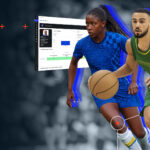Over the next two months the basketball world will focus on the NBA, where the NCAAs most talented prospects will seek to showcase their potential ahead of the June 25th draft. This multi-day combine involves a multitude of physical and skill-based tests that are designed to determine each player’s ultimate ability to compete at basketball’s highest level.
Physical tests include objective measurements such as height, weight, and wingspan. Similarly, performance is gauged through strength (bench press), power (vertical jump height), speed (¾ court sprint), and agility (lane shuttles), while skill-based drills include 3 point accuracy and shooting accuracy from dribble (% of 25 shots) and shooting on the move under time constraint (e.g. 35 seconds). The argument has been made for injury screening tests to be included in this process, as they are designed to detect players who may be predisposed to developing specific injuries. This is arguably an important consideration for each team when making selections, but there are some critical factors to take into account before integrating these screens in to the selection process.
As an example, we can take a closer look at the second most common area of injury in basketball: the ACL. The mechanisms for this type of injury were described in a previous post, effectively demonstrating that ACL issues are severe in nature and result in substantial time loss. However, the increased attention around ACL injury is not representative of actual increased incidence of injury in the sport. In fact, ACL injury trends have remained stable since 2010, with number of ACL injuries remaining between 5-6 incidences per season.
It is due to the severity of these injuries that media attention around ACL incidence has increased, and so although the importance of injury screening is not in question, we argue that integrating screening procedures as a component in talent identification may not be best practice going forward. As Timothy Hewett (primary researcher in the domain of ACL injury and basketball) noted, injury prediction is akin to meteorology: just because there is a 70% chance of rain does not mean it will rain, and just because a player is more likely to sustain an ACL injury does not mean that they will. Likewise, low predisposition to ACL injury does not mean injury will not occur. Instead, particularly with advances in treatment and prevention, likelihood of ACL injury should not impinge on opportunities afforded to prospective NBA players to fulfill their potential in basketball careers.
Ongoing monitoring of multi-faceted injury risk factors can be effective in identifying and reducing risk of injury prior to occurrence. Similarly, retraining foot-strike position, modifying stride pattern, and training neuromuscular response to landing have also been effective in reducing incidence of ACL injury across sports. Should these proactive measures fail, continual developments in ACL treatment are continually improving return-to-play outcomes. For example, in 2013 a new ligament was discovered in the knee – the antero-lateral ligament (ALL). The ALL is deeply embedded in tissue and thus has remained undiscovered until recently, and is now considered to be the root cause of poor ACL operative outcomes. ACL recoveries have previously been limited by prevailing weakness on pivot-shift motions, but repairing the ALL during ACL reconstruction now offers a more robust treatment with better return-to-play outcomes post knee injury.
One fact remains clear: injury prediction and prevention are constantly evolving, as are the various treatments for injuries once they have occurred. As such, the extent to which injury screens can offer value in talent identification events (such as the NBA combine) should continue to be taken under careful consideration.
Citations
- Busfield, B. T., Kharrazi, F. D., Starkey, C., Lombardo, S. J., & Seegmiller, J. (2009). Performance outcomes of anterior cruciate ligament reconstruction in the National Basketball Association. Arthroscopy: The Journal of Arthroscopic & Related Surgery, 25(8), 825-830.
- Harris, J. D., Erickson, B. J., Bach, B. R., Abrams, G. D., Cvetanovich, G. L., Forsythe, B., … & Cole, B. J. (2013). Return-to-sport and performance after anterior cruciate ligament reconstruction in National Basketball Association players. Sports Health: A Multidisciplinary Approach, 1941738113495788.
- Hewett, T. E., Myer, G. D., Ford, K. R., Heidt, R. S., Colosimo, A. J., McLean, S. G., … & Succop, P. (2005). Biomechanical measures of neuromuscular control and valgus loading of the knee predict anterior cruciate ligament injury risk in female athletes a prospective study. The American journal of sports medicine, 33(4), 492-501.
- Myer, G. D., Chu, D. A., Brent, J. L., & Hewett, T. E. (2008). Trunk and hip control neuromuscular training for the prevention of knee joint injury. Clinics in sports medicine, 27(3), 425-448.
- Zazulak, B. T., Hewett, T. E., Reeves, N. P., Goldberg, B., & Cholewicki, J. (2007). Deficits in neuromuscular control of the trunk predict knee injury risk a prospective biomechanical-epidemiologic study. The American journal of sports medicine, 35(7), 1123-1130.



